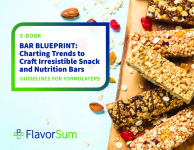Super Gum 'wows' as delivery system for food
water-in-oil-in-water emulsions, opening up opportunities for fat
reduction and novel encapsulation, researchers from New Zealand
have reported.
The research taps into growing interest in the development of water-in-oil-in-water (W/O/W) emulsions.
These 'double' emulsions involve water-based droplets dispersed inside oil droplets further dispersed inside an aqueous phase.
Current application of the technique is limited due to difficulties with the stability of the internal water droplets, a problem that could be solved by using the protein-polysaccharide conjugates.
"W/O/W emulsions formed with Super Gum were found to be stable over a wide pH range, compared to W/O/W emulsions stabilised with sodium caseinate, and thus, may be suitable for applications over a wide range of pH values, as may occur during ingestion or incorporation into different food systems," wrote lead author Jiahong Su from Massey University.
Use of the modified gum arabic product could also lead to a desirable reduction in the use of polyglycerol polyricinoleate (PGPR) - a synthetic ingredient said to be the most effective hydrophobic emulsifier available but strictly regulated.
Writing in the journal Food Hydrocolloids , Su and co-workers report that the double emulsions were prepared using a two-step process.
The inner aqueous phase consisted of water and varying concentrations of sodium caseinate or Super Gum (San-Ei Gen, Japan), and this was homogenised (distributed evenly) to form the emulsion with the oil phase - polyglycerol polyricinoleate (PGPR 4150, Palsgaard) and soybean oil (AMCO, New Zealand).
The double emulsion was subsequently prepared by homogenising this water-in-oil emulsion with a second aqueous phase containing the sodium caseinate (0.5 per cent) or Super Gum (0 to 15 per cent).
The researchers report that the W/O/W emulsions prepared using the Super Gum at a concentration of 10 per cent formed stable droplets with diameters ranging from one to ten micrometers in the pH range 7 to 2 (neutral to acidic), while emulsions prepared using sodium caseinate increased dramatically on increasing acidity.
Encapsulation efficiency (EE) of the internal water phase was also measured and found to be affected by sodium caseinate, Super Gum and PGPR concentrations.
"When 0.5 per cent sodium caseinate was used as emulsifier, increased EE was obtained as PGPR concentration increased and two per cent PGPR was the minimum concentration required to obtain an EE over 90 per cent," stated the researchers.
"The replacement of 0.5 per cent sodium caseinate in the external aqueous phase with 10 per cent Super Gum, however, significantly increased the EE in W/O/W emulsions prepared with 0.5 to 1.0 per cent PGPR."
"Therefore, 10 per cent Super Gum can further reduce the amount of PGPR required to stabilise W/O/W emulsions while still retaining a high EE."
The increased stability of the Super Gum emulsions compared to sodium caseinate is related to their respective structures, said the researchers.
Previous studies have reported that standard gum arabic forms thick, viscoelastic stabilising adsorbed layers at the oil-water interface, and since the modified gum arabic, Super Gum, is larger and its chemical structure contains more branched chains, Su said that this may result in the formation of thicker and more viscoelastic layers.
Such thick stabilising layers may render the emulsion droplet insensitive to dilution changes, making the emulsion stable in both concentrated and dilute forms, said Su.
"The findings suggested that W/O/W emulsions prepared with Super Gum may have advantages for use as a delivery system over a wide range of pH conditions," concluded the researchers.
"Future work will be focussed on elucidating the differences in the emulsion stabilising properties between sodium caseinate and Super Gum."
Source: Food Hydrocolloids (Elsevier) Published on-line ahead of print, doi: 10.1016/j.foodhyd.2007.03.005 "Improving encapsulation efficiency and stability of water-in-oil-in-water emulsions using a modified gum arabic (Acacia (sen) Super Gum)"
Authors: J. Su, J. Flanagan and H. Singh














